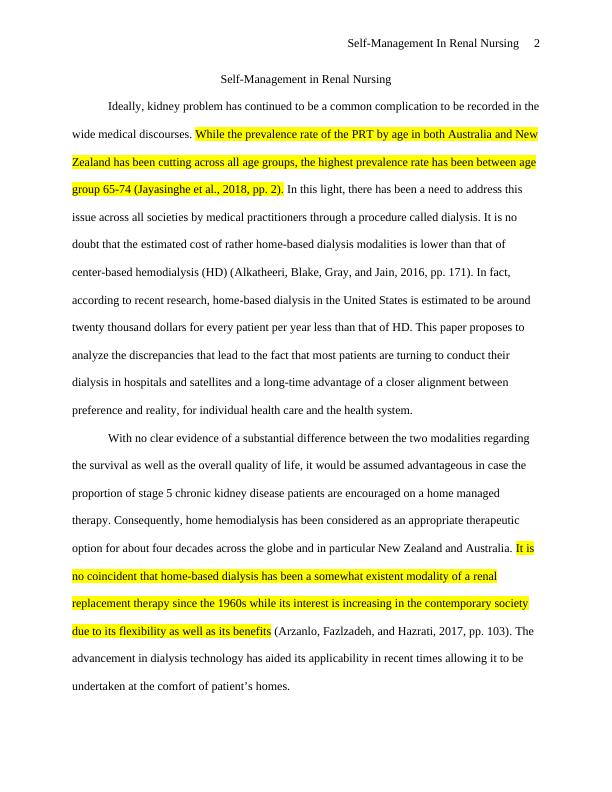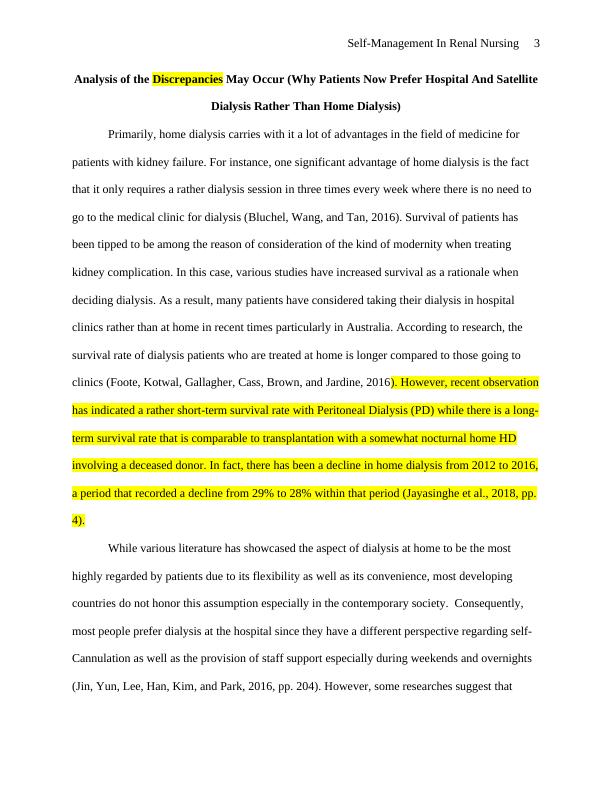Self-Management in Renal Nursing: Barriers and Evidence-Based Research
Added on 2023-06-09
9 Pages1910 Words55 Views
Self-Management In Renal Nursing 1
SELF MANAGEMENT IN RENAL NURSING
Name
Tutor
University
Course
City/State
Date
SELF MANAGEMENT IN RENAL NURSING
Name
Tutor
University
Course
City/State
Date

Self-Management In Renal Nursing 2
Self-Management in Renal Nursing
Ideally, kidney problem has continued to be a common complication to be recorded in the
wide medical discourses. While the prevalence rate of the PRT by age in both Australia and New
Zealand has been cutting across all age groups, the highest prevalence rate has been between age
group 65-74 (Jayasinghe et al., 2018, pp. 2). In this light, there has been a need to address this
issue across all societies by medical practitioners through a procedure called dialysis. It is no
doubt that the estimated cost of rather home-based dialysis modalities is lower than that of
center-based hemodialysis (HD) (Alkatheeri, Blake, Gray, and Jain, 2016, pp. 171). In fact,
according to recent research, home-based dialysis in the United States is estimated to be around
twenty thousand dollars for every patient per year less than that of HD. This paper proposes to
analyze the discrepancies that lead to the fact that most patients are turning to conduct their
dialysis in hospitals and satellites and a long-time advantage of a closer alignment between
preference and reality, for individual health care and the health system.
With no clear evidence of a substantial difference between the two modalities regarding
the survival as well as the overall quality of life, it would be assumed advantageous in case the
proportion of stage 5 chronic kidney disease patients are encouraged on a home managed
therapy. Consequently, home hemodialysis has been considered as an appropriate therapeutic
option for about four decades across the globe and in particular New Zealand and Australia. It is
no coincident that home-based dialysis has been a somewhat existent modality of a renal
replacement therapy since the 1960s while its interest is increasing in the contemporary society
due to its flexibility as well as its benefits (Arzanlo, Fazlzadeh, and Hazrati, 2017, pp. 103). The
advancement in dialysis technology has aided its applicability in recent times allowing it to be
undertaken at the comfort of patient’s homes.
Self-Management in Renal Nursing
Ideally, kidney problem has continued to be a common complication to be recorded in the
wide medical discourses. While the prevalence rate of the PRT by age in both Australia and New
Zealand has been cutting across all age groups, the highest prevalence rate has been between age
group 65-74 (Jayasinghe et al., 2018, pp. 2). In this light, there has been a need to address this
issue across all societies by medical practitioners through a procedure called dialysis. It is no
doubt that the estimated cost of rather home-based dialysis modalities is lower than that of
center-based hemodialysis (HD) (Alkatheeri, Blake, Gray, and Jain, 2016, pp. 171). In fact,
according to recent research, home-based dialysis in the United States is estimated to be around
twenty thousand dollars for every patient per year less than that of HD. This paper proposes to
analyze the discrepancies that lead to the fact that most patients are turning to conduct their
dialysis in hospitals and satellites and a long-time advantage of a closer alignment between
preference and reality, for individual health care and the health system.
With no clear evidence of a substantial difference between the two modalities regarding
the survival as well as the overall quality of life, it would be assumed advantageous in case the
proportion of stage 5 chronic kidney disease patients are encouraged on a home managed
therapy. Consequently, home hemodialysis has been considered as an appropriate therapeutic
option for about four decades across the globe and in particular New Zealand and Australia. It is
no coincident that home-based dialysis has been a somewhat existent modality of a renal
replacement therapy since the 1960s while its interest is increasing in the contemporary society
due to its flexibility as well as its benefits (Arzanlo, Fazlzadeh, and Hazrati, 2017, pp. 103). The
advancement in dialysis technology has aided its applicability in recent times allowing it to be
undertaken at the comfort of patient’s homes.

Self-Management In Renal Nursing 3
Analysis of the Discrepancies May Occur (Why Patients Now Prefer Hospital And Satellite
Dialysis Rather Than Home Dialysis)
Primarily, home dialysis carries with it a lot of advantages in the field of medicine for
patients with kidney failure. For instance, one significant advantage of home dialysis is the fact
that it only requires a rather dialysis session in three times every week where there is no need to
go to the medical clinic for dialysis (Bluchel, Wang, and Tan, 2016). Survival of patients has
been tipped to be among the reason of consideration of the kind of modernity when treating
kidney complication. In this case, various studies have increased survival as a rationale when
deciding dialysis. As a result, many patients have considered taking their dialysis in hospital
clinics rather than at home in recent times particularly in Australia. According to research, the
survival rate of dialysis patients who are treated at home is longer compared to those going to
clinics (Foote, Kotwal, Gallagher, Cass, Brown, and Jardine, 2016). However, recent observation
has indicated a rather short-term survival rate with Peritoneal Dialysis (PD) while there is a long-
term survival rate that is comparable to transplantation with a somewhat nocturnal home HD
involving a deceased donor. In fact, there has been a decline in home dialysis from 2012 to 2016,
a period that recorded a decline from 29% to 28% within that period (Jayasinghe et al., 2018, pp.
4).
While various literature has showcased the aspect of dialysis at home to be the most
highly regarded by patients due to its flexibility as well as its convenience, most developing
countries do not honor this assumption especially in the contemporary society. Consequently,
most people prefer dialysis at the hospital since they have a different perspective regarding self-
Cannulation as well as the provision of staff support especially during weekends and overnights
(Jin, Yun, Lee, Han, Kim, and Park, 2016, pp. 204). However, some researches suggest that
Analysis of the Discrepancies May Occur (Why Patients Now Prefer Hospital And Satellite
Dialysis Rather Than Home Dialysis)
Primarily, home dialysis carries with it a lot of advantages in the field of medicine for
patients with kidney failure. For instance, one significant advantage of home dialysis is the fact
that it only requires a rather dialysis session in three times every week where there is no need to
go to the medical clinic for dialysis (Bluchel, Wang, and Tan, 2016). Survival of patients has
been tipped to be among the reason of consideration of the kind of modernity when treating
kidney complication. In this case, various studies have increased survival as a rationale when
deciding dialysis. As a result, many patients have considered taking their dialysis in hospital
clinics rather than at home in recent times particularly in Australia. According to research, the
survival rate of dialysis patients who are treated at home is longer compared to those going to
clinics (Foote, Kotwal, Gallagher, Cass, Brown, and Jardine, 2016). However, recent observation
has indicated a rather short-term survival rate with Peritoneal Dialysis (PD) while there is a long-
term survival rate that is comparable to transplantation with a somewhat nocturnal home HD
involving a deceased donor. In fact, there has been a decline in home dialysis from 2012 to 2016,
a period that recorded a decline from 29% to 28% within that period (Jayasinghe et al., 2018, pp.
4).
While various literature has showcased the aspect of dialysis at home to be the most
highly regarded by patients due to its flexibility as well as its convenience, most developing
countries do not honor this assumption especially in the contemporary society. Consequently,
most people prefer dialysis at the hospital since they have a different perspective regarding self-
Cannulation as well as the provision of staff support especially during weekends and overnights
(Jin, Yun, Lee, Han, Kim, and Park, 2016, pp. 204). However, some researches suggest that

End of preview
Want to access all the pages? Upload your documents or become a member.
Related Documents
Chronic Kidney Disease | Case Studylg...
|8
|1731
|72
Hyperkalemia and Barriers to Self Managementlg...
|8
|1781
|336
Case Study on Hypertension leading to End stage renal diseaseslg...
|14
|5832
|220
Interprofessional Collaborative Practices in Chronic Kidney Disease Managementlg...
|11
|2399
|481
End-Stage Kidney Disease (ESKD)lg...
|4
|763
|76
Renal Transplant: Procedure, Anatomy and Physiology of Kidney, and Potential Complicationslg...
|13
|4195
|491
